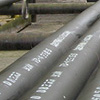
Stress on High-frequency Straight Seam Resistance Welding Pipe Grooving Corrosion
تاريخ:2016-08-29
رأي:2496
High-frequency electric resistance welded (ERW) pipe as a whole without heat treatment, to achieve circumferential weld residual stress around 350MPa, close to the yield strength of the pipe. When the weld processing into working electrode, the residual stress is reduced to 100MPa or less. Circumferential tensile stress can reduce the corrosion potential of welds, accelerated corrosion, increased sensitivity coefficient trench etching after the heat treatment of the welded pipe, the circumferential weld tensile residual stress is small, to 10 ~ 100MPa, after processing into a working electrode its circumferential tensile stress is little change.
Trench etching is generally believed that acute heat in the welding process, the results of local tissue metal and chemical change caused by quenching. In the high frequency resistance welding process, within the initial 0.1s, temperature was raised to 1600 ℃, the integration process section MnS decomposed into S or converted to FeS, within the next 4 ~ 6s, the temperature dropped to 400 ℃, then water-cooled to room temperature. S and sulfide-rich seam zone is through the rapid heating, rapid cooling to achieve. For high sulfur content (mass fraction> 0.01%) steel, the corrosion of the trench produce MnS inclusions about; the loss of low sulfur content steel trench produces solder alloy, residual stress and increase the carbon content related.
Uneven temperature field of welding process is a root cause of welding stress and deformation. In the small thickness of the weldments, welding residual stress is substantially plane stress, stress in the thickness direction is small. In the free state the welding plate, in the vicinity of the weld and the tensile stress is generally in the stress away from the weld compared. Residual Stress can affect the strength of the weldment, stiffness, stability, accuracy and corrosion resistance. The elimination of residual stress, the general overall heat treatment. Since the annealing temperature is too high will result in material strength and organizational changes or the second phase precipitates, the annealing temperature is too low to remove the effects of residual stress is unlikely, therefore, to the steel to stress annealing 500 ℃ 1h, after slow cooling, reducing the welding residual stress member, improve the uniformity of the organization and composition. Correspondence between before and after heat treatment corrosion current density and tensile stress, it can be seen, not heat-treated samples corrosion current density increases with the tensile stress significantly increased, and the corrosion current density is much larger than the sample after the heat treatment. It showed that after heat treatment, corrosion resistance ERW welded plate significantly improved.
Trench etching is generally believed that acute heat in the welding process, the results of local tissue metal and chemical change caused by quenching. In the high frequency resistance welding process, within the initial 0.1s, temperature was raised to 1600 ℃, the integration process section MnS decomposed into S or converted to FeS, within the next 4 ~ 6s, the temperature dropped to 400 ℃, then water-cooled to room temperature. S and sulfide-rich seam zone is through the rapid heating, rapid cooling to achieve. For high sulfur content (mass fraction> 0.01%) steel, the corrosion of the trench produce MnS inclusions about; the loss of low sulfur content steel trench produces solder alloy, residual stress and increase the carbon content related.
Uneven temperature field of welding process is a root cause of welding stress and deformation. In the small thickness of the weldments, welding residual stress is substantially plane stress, stress in the thickness direction is small. In the free state the welding plate, in the vicinity of the weld and the tensile stress is generally in the stress away from the weld compared. Residual Stress can affect the strength of the weldment, stiffness, stability, accuracy and corrosion resistance. The elimination of residual stress, the general overall heat treatment. Since the annealing temperature is too high will result in material strength and organizational changes or the second phase precipitates, the annealing temperature is too low to remove the effects of residual stress is unlikely, therefore, to the steel to stress annealing 500 ℃ 1h, after slow cooling, reducing the welding residual stress member, improve the uniformity of the organization and composition. Correspondence between before and after heat treatment corrosion current density and tensile stress, it can be seen, not heat-treated samples corrosion current density increases with the tensile stress significantly increased, and the corrosion current density is much larger than the sample after the heat treatment. It showed that after heat treatment, corrosion resistance ERW welded plate significantly improved.

























